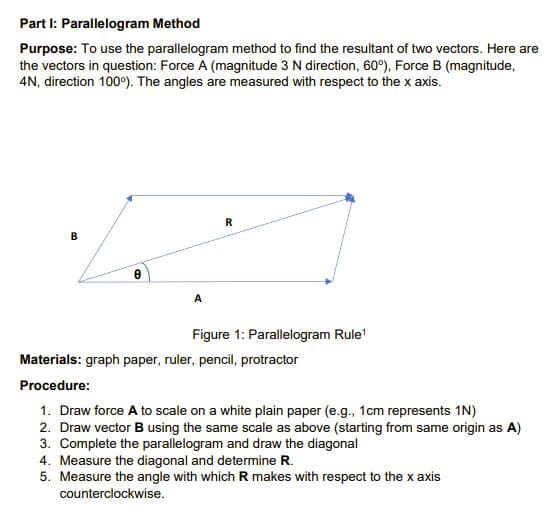Part I: Parallelogram Method Purpose: To use the parallelogram method to find the resultant of two vectors. Here are the vectors in question: Force A (magnitude 3 N direction, 60°), Force B (magnitude, 4N, direction 100°). The angles are measured with respect to the x axis. R B A Figure 1: Parallelogram Rule! Materials: graph paper, ruler, pencil, protractor Procedure: 1. Draw force A to scale on a white plain paper (e.g., 1cm represents 1N) 2. Draw vector B using the same scale as above (starting from same origin as A) 3. Complete the parallelogram and draw the diagonal 4. Measure the diagonal and determine R. 5. Measure the angle with which R makes with respect to the x axis counterclockwise.
Part I: Parallelogram Method Purpose: To use the parallelogram method to find the resultant of two vectors. Here are the vectors in question: Force A (magnitude 3 N direction, 60°), Force B (magnitude, 4N, direction 100°). The angles are measured with respect to the x axis. R B A Figure 1: Parallelogram Rule! Materials: graph paper, ruler, pencil, protractor Procedure: 1. Draw force A to scale on a white plain paper (e.g., 1cm represents 1N) 2. Draw vector B using the same scale as above (starting from same origin as A) 3. Complete the parallelogram and draw the diagonal 4. Measure the diagonal and determine R. 5. Measure the angle with which R makes with respect to the x axis counterclockwise.
Physics for Scientists and Engineers, Technology Update (No access codes included)
9th Edition
ISBN:9781305116399
Author:Raymond A. Serway, John W. Jewett
Publisher:Raymond A. Serway, John W. Jewett
Chapter11: Angular Momentum
Section: Chapter Questions
Problem 11.3OQ: Let us name three perpendicular directions as right, up, and toward you as you might name them when...
Related questions
Question
100%

Transcribed Image Text:Part I: Parallelogram Method
Purpose: To use the parallelogram method to find the resultant of two vectors. Here are
the vectors in question: Force A (magnitude 3 N direction, 60°), Force B (magnitude,
4N, direction 100°). The angles are measured with respect to the x axis.
R
B
A
Figure 1: Parallelogram Rule!
Materials: graph paper, ruler, pencil, protractor
Procedure:
1. Draw force A to scale on a white plain paper (e.g., 1cm represents 1N)
2. Draw vector B using the same scale as above (starting from same origin as A)
3. Complete the parallelogram and draw the diagonal
4. Measure the diagonal and determine R.
5. Measure the angle with which R makes with respect to the x axis
counterclockwise.
Expert Solution
This question has been solved!
Explore an expertly crafted, step-by-step solution for a thorough understanding of key concepts.
This is a popular solution!
Trending now
This is a popular solution!
Step by step
Solved in 3 steps with 1 images

Recommended textbooks for you

Physics for Scientists and Engineers, Technology …
Physics
ISBN:
9781305116399
Author:
Raymond A. Serway, John W. Jewett
Publisher:
Cengage Learning

Principles of Physics: A Calculus-Based Text
Physics
ISBN:
9781133104261
Author:
Raymond A. Serway, John W. Jewett
Publisher:
Cengage Learning

University Physics Volume 1
Physics
ISBN:
9781938168277
Author:
William Moebs, Samuel J. Ling, Jeff Sanny
Publisher:
OpenStax - Rice University

Physics for Scientists and Engineers, Technology …
Physics
ISBN:
9781305116399
Author:
Raymond A. Serway, John W. Jewett
Publisher:
Cengage Learning

Principles of Physics: A Calculus-Based Text
Physics
ISBN:
9781133104261
Author:
Raymond A. Serway, John W. Jewett
Publisher:
Cengage Learning

University Physics Volume 1
Physics
ISBN:
9781938168277
Author:
William Moebs, Samuel J. Ling, Jeff Sanny
Publisher:
OpenStax - Rice University

Physics for Scientists and Engineers: Foundations…
Physics
ISBN:
9781133939146
Author:
Katz, Debora M.
Publisher:
Cengage Learning